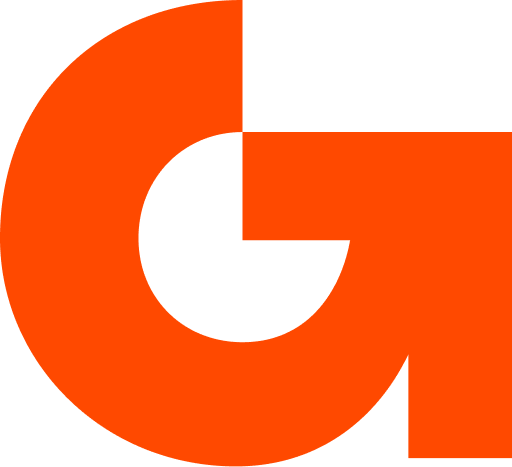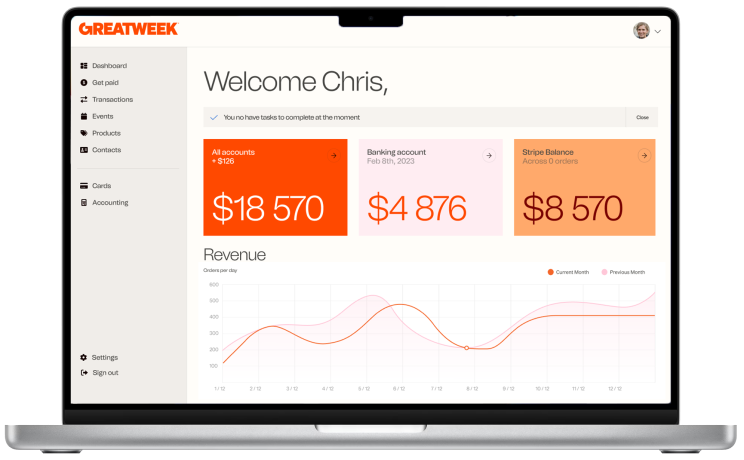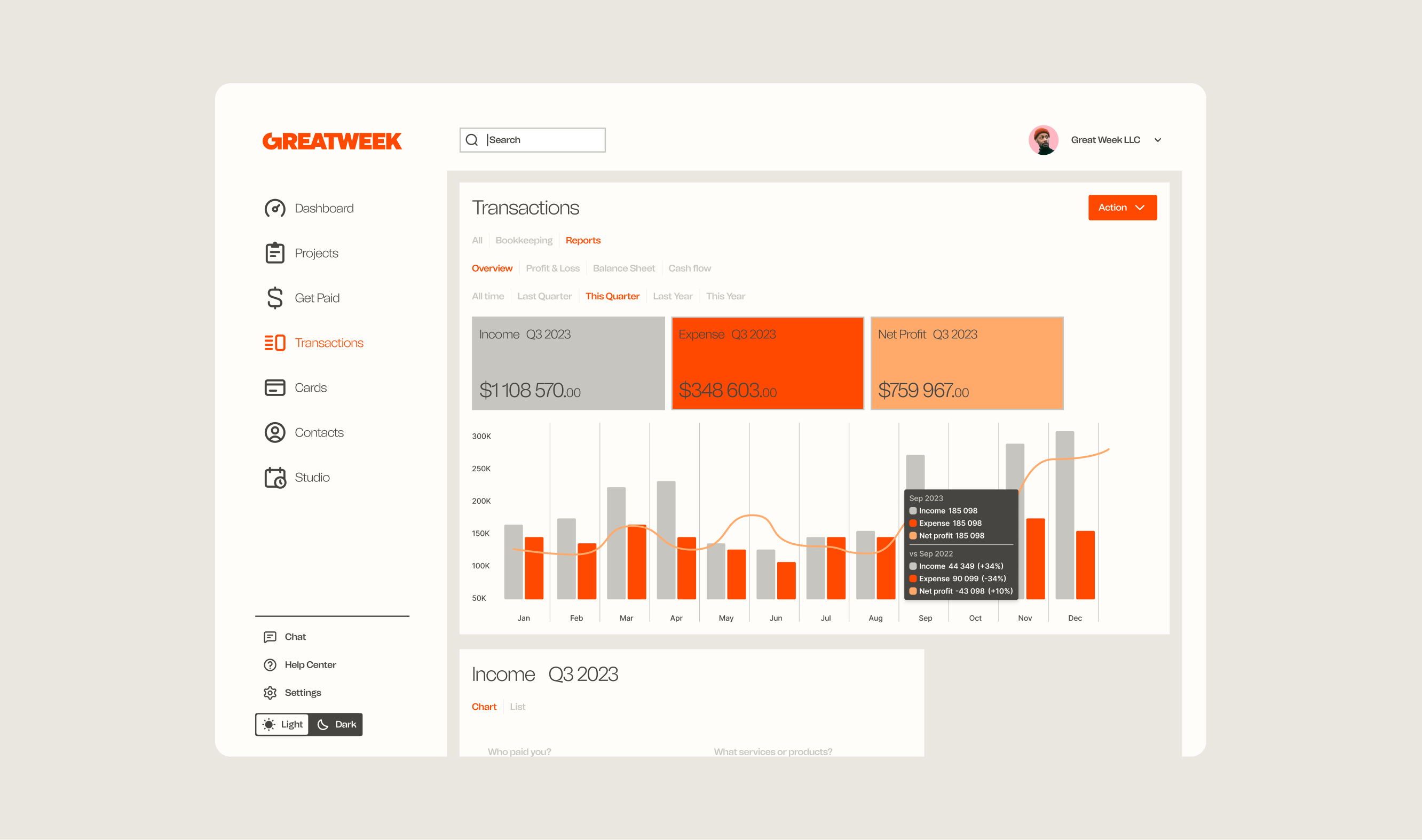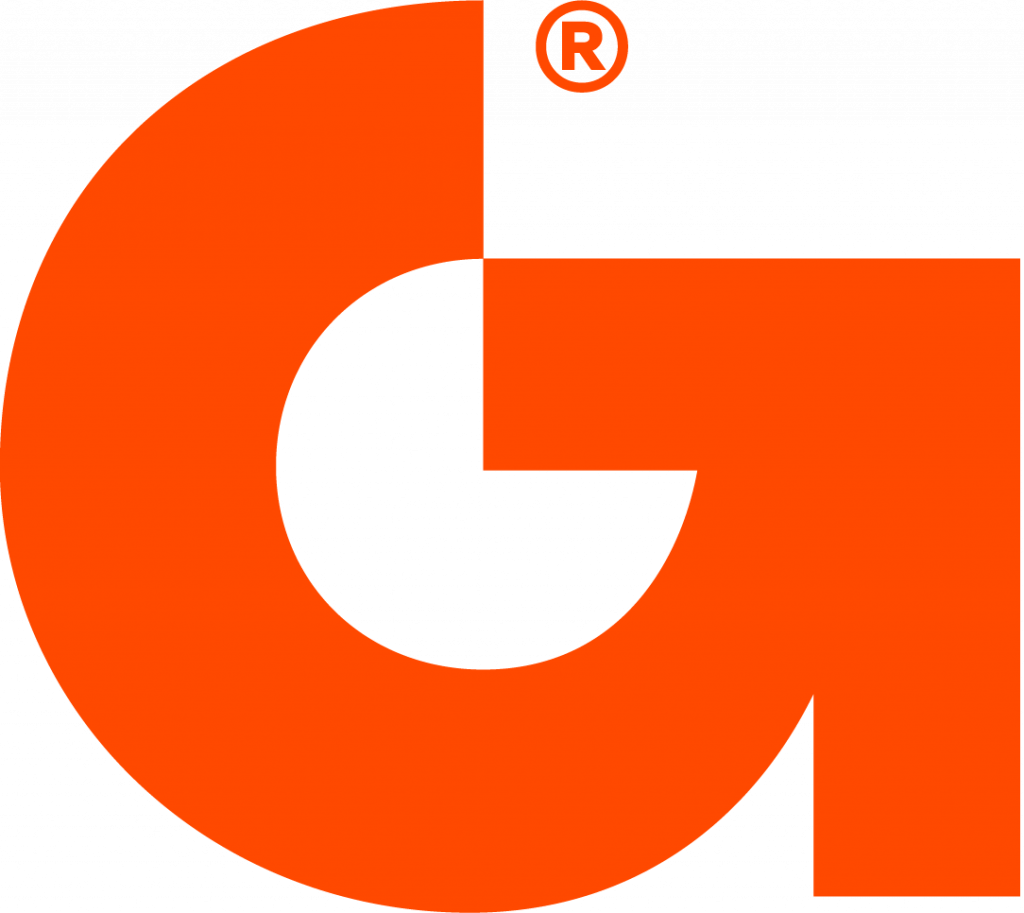Getting paid is great, but sending invoices can be painful. You have to itemize charges, add taxes, track who paid, and chase down clients who don’t pay. It’s time-consuming, and it’s definitely not why you got into your business in the first place.
Free invoicing software makes the billing process a whole lot easier. With the click of a few buttons, you can create client profiles, add payment options, include expenses, and even add your logo. Tap a few more buttons to deliver that invoice to your client’s inbox.
Streamline your invoicing workflows with automation
And with so many great free invoicing tools out there today, you can streamline the process without any upfront investment. To help you avoid analysis paralysis, I researched more than 45 free invoicing apps and spent several days testing the top 25 contenders. Here’s what I found.
The best free invoicing software
- Greatweek sorry, we are biased : )
- Wave for growing businesses
- PayPal for a familiar name
- Zoho Invoice for free invoicing with a mini-CRM
- Square for in-person sales
- Invoice Home for a simple invoicing solution
- Paymo for time-based invoicing
What makes the best free billing software?
How we evaluate and test apps
All of our best apps roundups are written by humans who’ve spent much of their careers using, testing, and writing about software. We spend dozens of hours researching and testing apps, using each app as it’s intended to be used and evaluating it against the criteria we set for the category. We’re never paid for placement in our articles from any app or for links to any site—we value the trust readers put in us to offer authentic evaluations of the categories and apps we review.
There’s no one perfect solution when it comes to the best free invoicing tools. That’s because every business is different—a freelance SEO consultant, for example, needs different features than a business coach.
To find the best platforms, I signed up for a free version of each and tested it by creating and customizing a few invoices, adding new clients, digging into the report settings, and testing any automation features. As I tested, I considered:
- Value of the free plan. Not all free plans are worth it. Some “free” plans are just lead magnets to get you to sign up for a paid plan. All the invoicing tools on this list offer a solid suite of features for free.
- Ability to customize invoices. Branding is what sets your business apart. Customizing your invoice to add brand colors and logos also helps your clients know your invoice is legitimate. I tested all the customization features for each of these invoice tools.
- Reporting tools. Knowing where your money is going is crucial to running a successful business. I looked for invoicing tools that offer robust reporting features, so you can see where you stand.
- Recurring billing. Whether you have a subscription-based company or use retainers, being able to bill automatically can save you tons of time. I looked specifically for tools that offer this feature whenever possible.
If you only send one or two invoices a month, you might not need the bells and whistles of a complete platform. In that case, you can use this invoice template in Google Docs and just email it off when it’s ready.
Another important thing to note: all online payments require the use of a payment gateway—a service that processes card and bank payments. So even though the invoicing software itself is free to use, all of the apps charge payment processing and transaction fees for accepting payments. Those fees are automatically deducted from any payment you receive.
Some of the tools below—like PayPal and Stripe—are payment gateways. Others use third-party payment gateways to process payments. For invoicing apps that are also payment gateways, I’ve listed the applicable fees. For those that use third-party payment gateways, the fees are typically subject to the terms of the payment gateway you use to accept payments.
Note: Quoted payment processing and transaction fees apply only to payments sent to and received from individuals within the United States. International fees may vary by both provider and location.
What about invoice generators?
There are a zillion one-off “invoice generators” out there—tools where you plug in some information and it spits out an invoice—but I don’t recommend them.
Invoice generators offer short-term speed in exchange for a general lack of customizability, tracking, and long-term convenience. They also don’t offer any way to accept payments—meaning you’ll need to use a third-party payment gateway like PayPal or Stripe (which offer their own free invoicing features already) on top of it. Plus, many of the tools below are so simple and user-friendly, there’s just no reason you should have to accept those trade-offs—even if your invoicing needs are infrequent.
The best free invoicing software at a glance
Greatweek (Web, iOS, Android)

Discover the power of Greatweek: the user-friendly, all-in-one business app that will revolutionize your invoicing and expense tracking. With its full feature set, including built-in accounting features and a native payment processor, Greatweek is the ultimate solution for entrepreneurs on the go.
Sending invoices has never been easier with Greatweek’s intuitive navigation and customizable templates. Create professional invoices in just a few clicks, customize the layout and design, and even add a logo or adjust the colors to reflect your brand. Need to apply a discount, tweak pricing, or add a personal note? Greatweek has got you covered.
But Greatweek doesn’t stop at invoicing. It goes above and beyond with additional features like payroll and tax filing, making it the perfect choice for growing businesses. Imagine having all your financial needs met in one place, eliminating the hassle of switching apps as your business expands. And with Greatweek Bank Account, you can even use it as your primary business bank account.
One of my favorite features is its automated bookkeeping, which effortlessly categorizes transactions and eliminates duplicate journal entries. This smart technology has saved me countless hours and made managing cash flow a breeze.
Don’t settle for mediocre invoicing and tracking tools. Try Greatweek today and experience the difference firsthand. Sign up now and streamline your business finances like never before.
Wave (Web, iOS, Android)
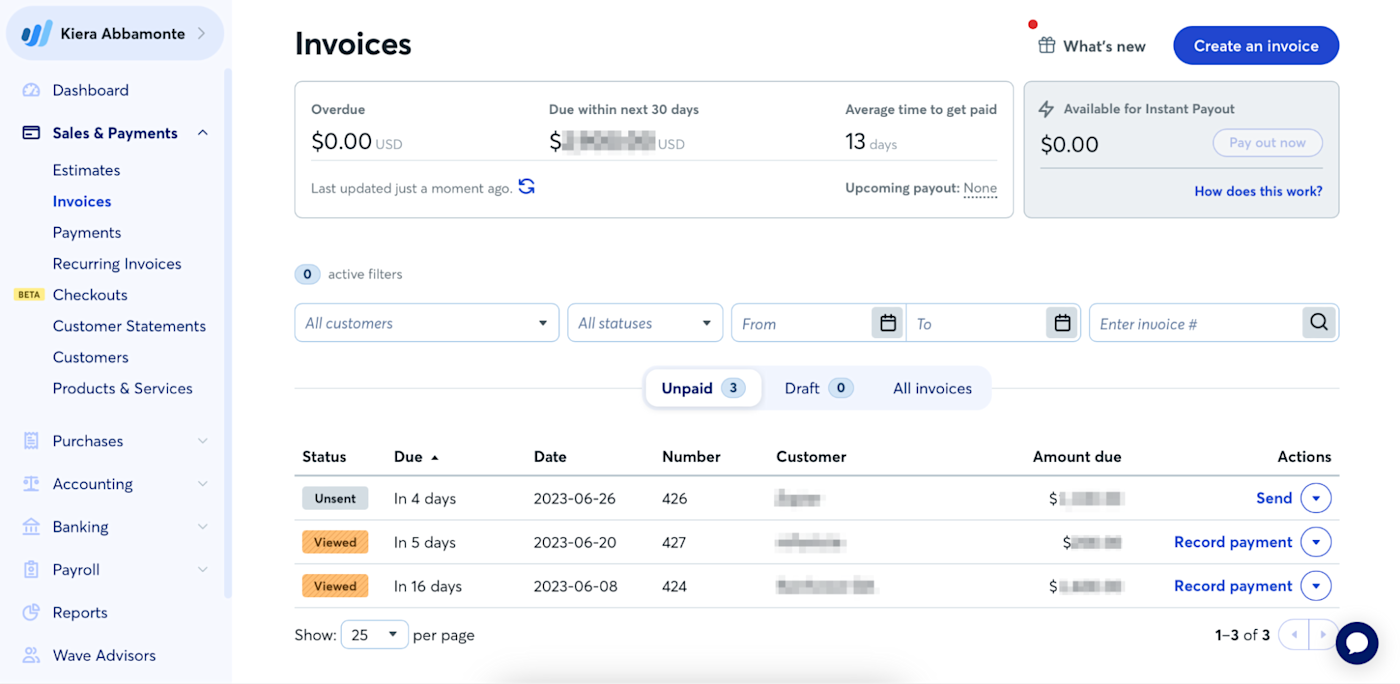
Wave pros:
- Super user-friendly, even on mobile
- Full feature set with accounting features
- Built-in native payment processor
Wave cons:
- Invoices aren’t as customizable as some other options
Wave is a solid option to send invoices and track where all your cash goes—including cash coming and going. It’s a full-featured business app that connects to your bank account to track expenses, send invoices, access detailed reports, and (if you need it) even reconcile your accounts for free.
Wave’s invoicing features are intuitive to navigate and include several templates, so you can customize the layout and design. To create an invoice, click Create a new on your dashboard, then select Invoice. Choose from several templates, add a logo, and adjust colors. Need to add a discount, adjust pricing, or add a note? You can do all that with the click of a button. And with Wave’s newly overhauled mobile app, you can do it from anywhere.
It’s the additional features, like payroll and tax filing, that make this platform ideal for growing businesses. You can even use Wave Money as your main business bank account. There’s a good chance you’ll need these additional features down the road. While the upgraded features aren’t free, they are affordable (Payroll, for example, starts at $20/month), and you won’t have to switch apps as your business grows.
But if all you need is invoicing, Wave is still one of the easiest and best options. As a freelancer operating on my own, I’ve used Wave for years, and I still love it. My favorite feature: automated bookkeeping automatically categorizes transactions and even merges duplicate journal entries (like recognizing that a wire transfer payment to your bank is the same as the invoice payment you logged in the app). I’ve watched this feature get smarter over the last few years, and it makes keeping track of cash flow so much easier.
What’s included in Wave’s free plan: All invoicing, accounting, and banking features
Wave payment processing fees: 2.9% + $0.60 per transaction for card payments (3.4% + $0.60 for card payments from American Express); 1% per transaction for bank payments (ACH)
Best free invoice app for a familiar name
PayPal (Web, iOS, Android)
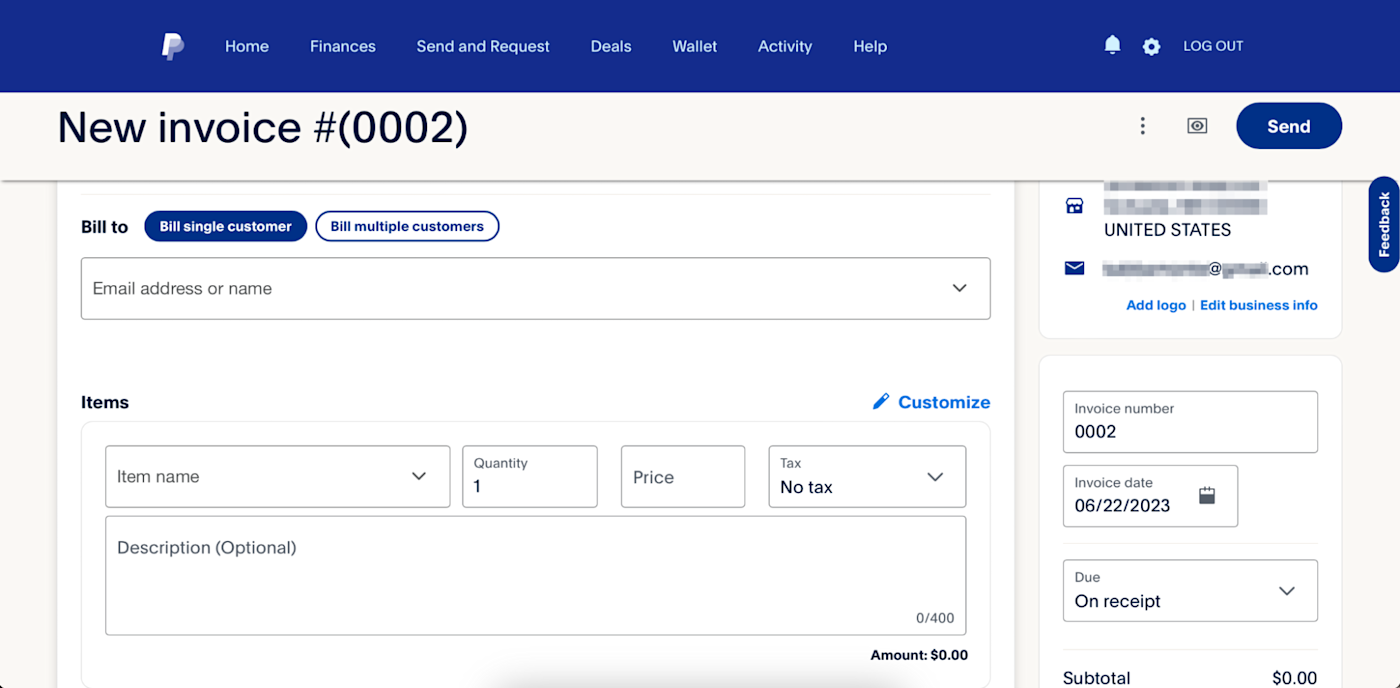
PayPal pros:
- Familiar, trusted name your clients will recognize
- Simple to use, with payments and invoicing all in one
PayPal cons:
- Limited feature set
PayPal Invoicing might not have all the bells and whistles—there’s no time tracking, full client profiles, or detailed subscription billing—but it works really well as a free invoice maker.
For starters, it’s straightforward to use. No complicated platform, no constant push to upgrade: just add your client’s name, contact info, and pricing, and send the invoice off. Invoice customization features include adding your own logo, including custom fields and notes, and sending payment reminders. You don’t have to create a client profile or add items to your inventory like some platforms make you do.
If you do want access to detailed features, like adding a client, they’re a little tough to track down. I ended up finding the client profile option while adding a client email to a new invoice (you’ll see a dropdown menu with the option to create a new client). The option to save invoice templates is also a little hidden: look for the three dots next to the Send button, and then tap Save as template.
PayPal is a highly trusted payment platform, which your clients might appreciate. They also offer a robust phone app, so you can send invoices from anywhere, anytime.
What’s included in PayPal’s free plan: Free to create an account and send invoices
PayPal payment processing fees: 3.49% + $0.49 per transaction for PayPal, Venmo, and Pay Later payments; 2.99% + $0.49 per transaction for debit and credit card payments
Best free invoicing software with a mini-CRM
Zoho Invoice (Web, macOS, Windows, iOS, Android)
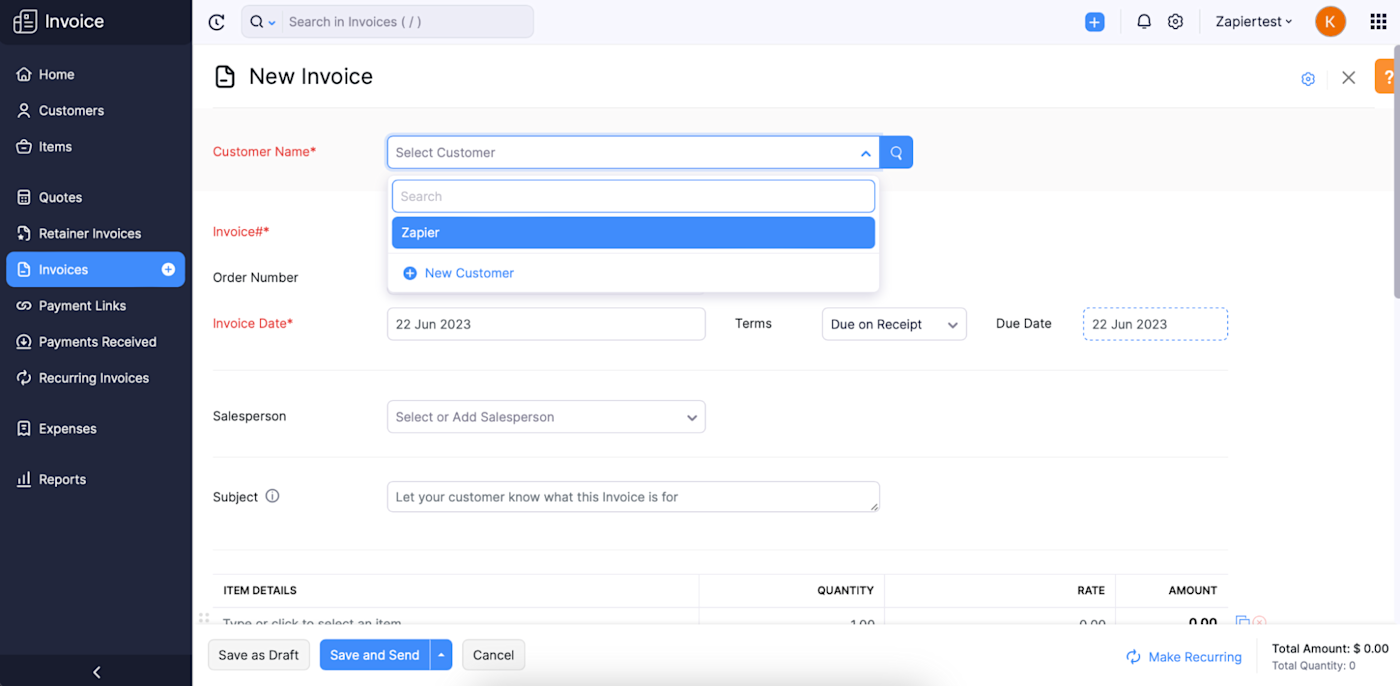
Zoho Invoice pros:
- Flexible, full-featured tool, including a customer portal
- Robust automation workflows
Zoho Invoice cons:
- Requires a separate tool to process payments (PayPal)
Zoho Invoice is one of the most impressive invoicing tools on this list. Honestly, I was amazed at all the features included in its free plan.
Sending an online invoice is simple: enter your business name, location, and currency. Customize your invoice by adding terms and conditions, uploading files, adjusting the invoice recipient, and adding taxes as needed. For recurring billing, just click the Make recurring link at the bottom of the invoice.
But running a business isn’t only about invoices. In addition to creating invoices, Zoho lets you send estimates, sign contracts, bill for retainers, track payments, and even track time. I also love how detailed the customer files are. In addition to name and email, you can keep track of their phone number, website, language, social media handles, and even add custom fields. This customization means you can adjust Zoho to fit your needs.
I also really like the customer portal feature, which I didn’t see on other apps. It allows the customer to see what they owe, payments made, and available credits. Inviting customers is as easy as sending an email, which Zoho automatically generates for you under the Customers tab.
Another place where Zoho shines is its automation features. You can create incredibly detailed workflows for actions like adding a discount if an invoice is paid early or sending a payment email reminder. It does take a little time to set up, but it can save you hours down the road.
What’s included in Zoho Invoice’s free plan: All features, including client portal
Zoho Invoice payment processing fees: Payments accepted through Zoho Invoice are made through third-party apps like PayPal, Stripe, and Square, so transaction fees vary based on the terms of your selected payment gateway.
Best free invoicing software for in-person businesses
Square (Web, iOS, Android)
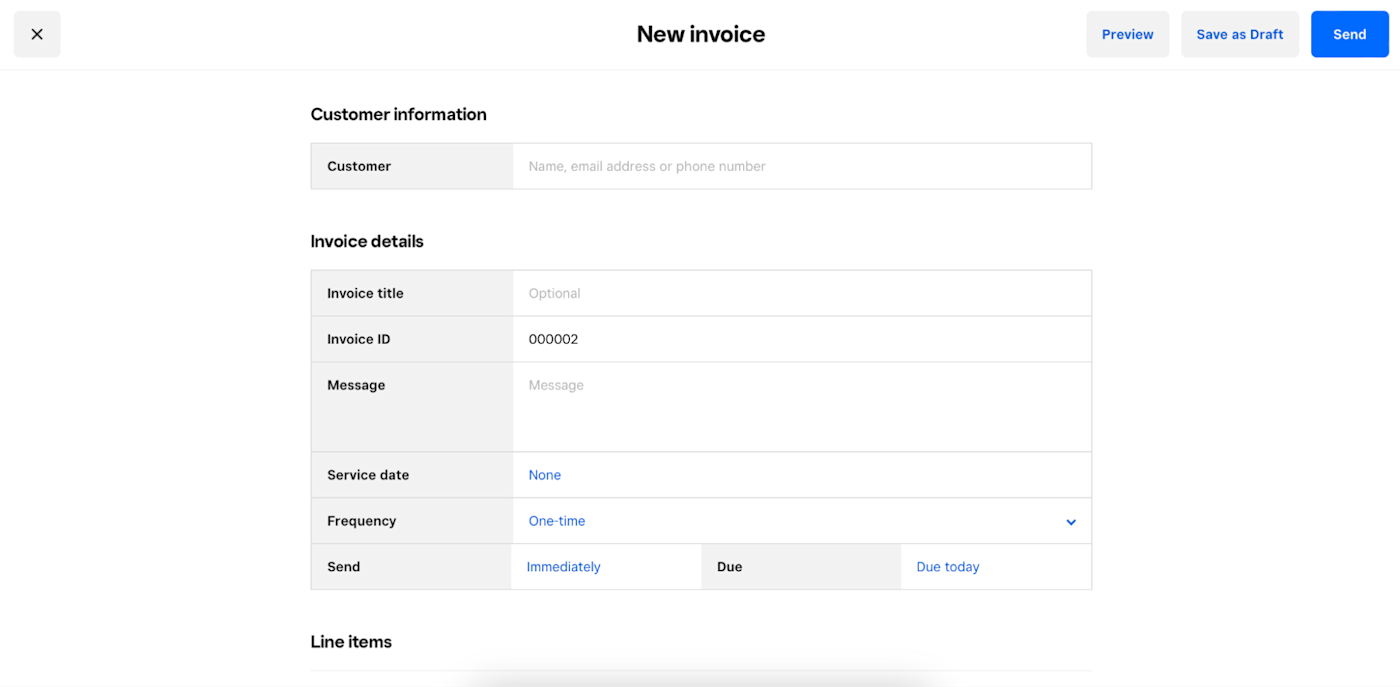
Square pros:
- Unifies online and brick-and-mortar invoices
- Robust inventory feature for both products and services
- Invoice and accept payments with one tool
Square cons:
- Fewer reports than other tools
If you want to sync online and offline sales, Square is your best option. In addition to sending invoices and selling online, you can also accept payments in person via the ubiquitous Square smartphone swiper.
Square offers a few options to customize your invoices in the account settings. You can add a logo, select a color, choose whether or not to display your address, and add custom text or a return policy.
The platform also lets you build an item library of products and services, which speeds up the invoice creation process. When creating an item, you can add information like SKU, size options, images, location, and other custom options. Then, when you’re ready to create an invoice, just click the Item line, and select the item from a dropdown menu.
Other strong features include the ability to send recurring invoices, schedule invoices to be sent at a later date, accept digital signatures, and schedule automatic payment reminders. Overall, it’s intuitive to use and full-featured. While it lacks some reporting features (it has only a few reports), it does allow users to accept in-person payments and send unlimited invoices for free.
What’s included in Square’s free plan: Free for point-of-sale payment processing and invoicing
Square payment processing fees: 3.3% + $0.30 per transaction for credit/debit card payments made on invoices; 1% per transaction for ACH bank transfers; 2.9% + $0.30 per transaction for Cash App Pay; 6% + $0.30 per transaction for AfterPay payments.
Best free invoicing software for a simple way to invoice
Invoice Home (Web, iOS, Android)
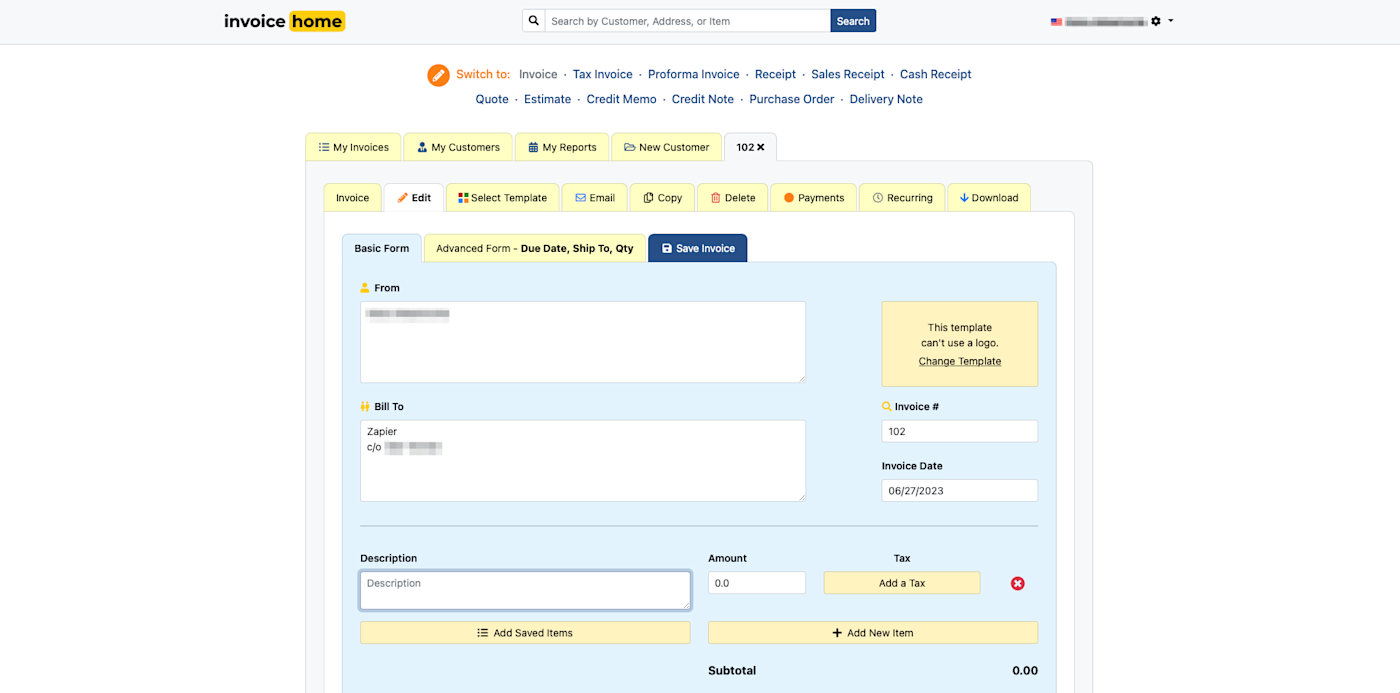
Invoice Home pros:
- Tons of highly-designed invoice templates
- Save your logo, customers, and product/service details
Invoice Home cons:
- Limited feature set (including a lack of real reports)
If you’re looking for a super simple invoicing option, look no further than Invoice Home. The app combines the simplicity of the very best invoice generators with the convenience of saving information on your customers, products, and services.
Once you sign up for an account, creating a new invoice is as simple as clicking Invoice in the list of available documents at the top of the page. Fill in the required info, select your template, and connect your payment gateway—Invoice Home works with PayPal, Stripe, and Authorize.net—and you’re good to go. The app offers a ton of highly-designed document templates, and you can add your logo to make it your own.
You can also use Invoice Home to build quick receipts, quotes, estimates, purchase orders, credit notes, and more—all with templates to match your invoices.
While you won’t find in-depth reporting features here, the main dashboard offers a simplified bird’s-eye view of all your invoices, with easy tabs to see which ones are overdue, partially paid, unpaid, and paid.
What’s included in Invoice Home’s free plan: Unclear. I reached out to their team to confirm because there aren’t any limits for the free plan listed anywhere. I was able to make more than 40 invoices without hitting a limit, but there is a $9/month “Unlimited Invoicing” plan.
Invoice Home payment processing fees: Payments accepted through Invoice Home are made through third-party apps like PayPal, Stripe, and Authorize.net, so transaction fees vary based on the terms of your selected payment gateway.
Best free invoicing software for time-based billing
Paymo (Web, macOS, Windows, iOS, Android, Linux)
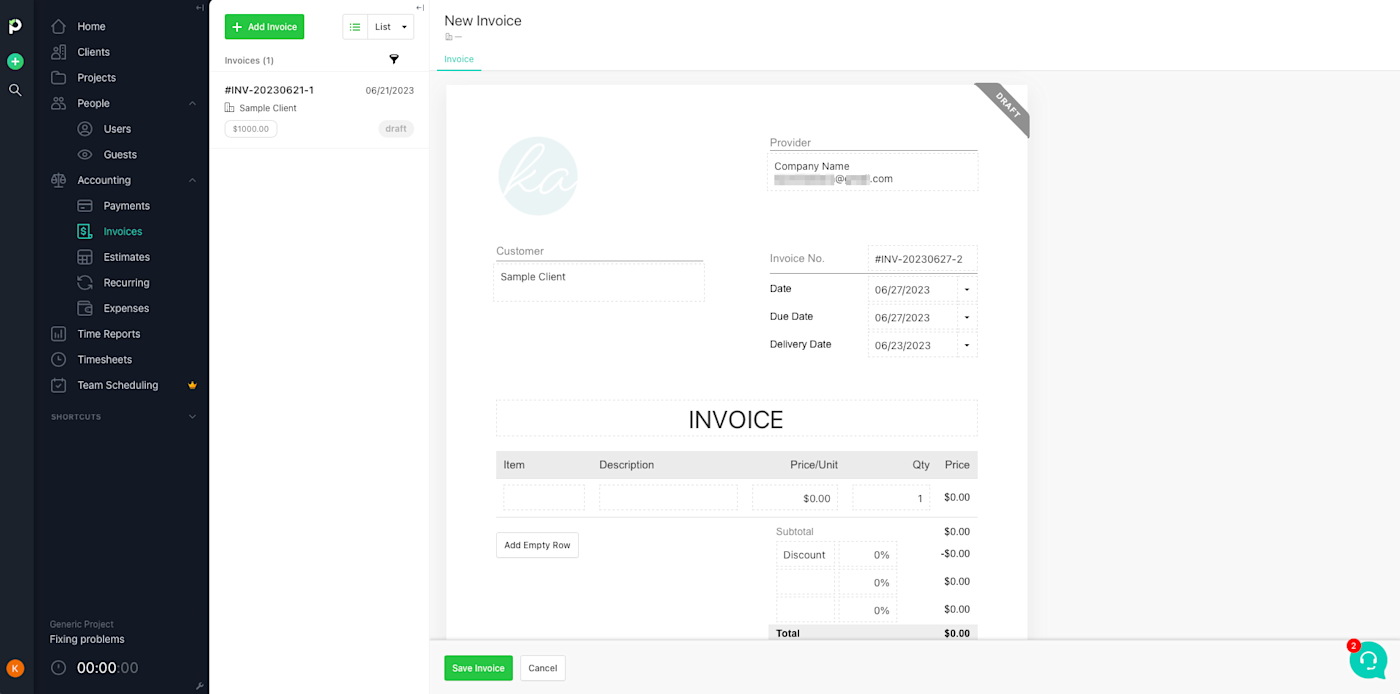
Paymo pros:
- Time-tracking, project management, and invoicing in one tool
- Easy to pull tracked time into invoices
- Reasonable upgrade cost
Paymo cons:
- Limited reporting and visual customization
Billing clients for time-based projects? Paymo is the way to go. While the app is primarily a project management and time-tracking solution, the invoicing feature is no slouch. And keeping those three functions under one roof makes billing for your time super quick and convenient.
When you create an invoice and select the applicable client, a dropdown appears where you can select billable projects to add to the invoice. Select the projects you want to bill for and click Add Projects. That’s it. You can set default hourly rates and invoice terms for each client, too, and save any important billing notes like your client’s billing address or email for invoices.
Paymo’s free plan is among the more restrictive—with a limit of one user and three clients—but the upgrade to a paid plan is super manageable when the time comes.
What’s included in Paymo’s free plan: Unlimited invoices and time tracking for up to 3 clients, 50 tasks, and 1 user
Paymo payment processing fees: Free users can accept payments through third-party gateways, including Stripe, Authorize.net, or PayPal—transaction fees vary for each. Paid users can apply for the native PM Payments by Paymo to accept credit card payments at 2.6% + $0.30 per transaction (intro rate) and ACH payments for 1% per transaction.
What’s the best free invoicing software?
An online invoice generator should do more than just give you a PDF to send via email. Your invoice program should function as fully-featured billing software that lets you take care of your online invoicing in the context of your business. Because these are all free, it’s worth taking a few of them for a spin to see which one makes your life the easiest.

